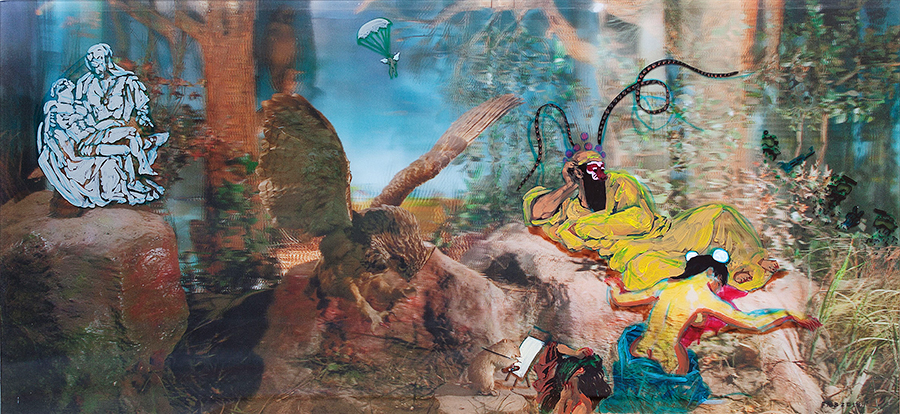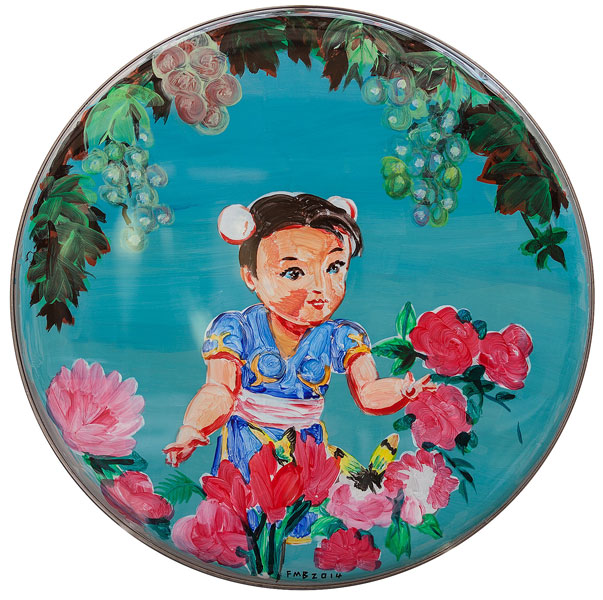People
Of Heroes And Nintendos: Interview With Feng Mengbo


Renowned for his large-scale video game installation Long March: Restart (2008), Beijing-based artist Feng Mengbo has acquired artistic knowledge through extensive research and studies, spanning from painting to traditional printmaking to computer programming. Within his multidisciplinary art practice, Feng broadly references themes of video game culture, historical narratives and childhood heroes. His latest show, “The Loudest is Silent: Picturing Feng Mengbo,” at Hong Kong’s Hanart TZ Gallery, showcases Feng’s most recent adventurous endeavor, which sees a return to his background in painting with an astonishing “hyperlinked” display of over 100 artworks. Just hours before the exhibition opening that took place earlier this month, Feng invited ArtAsiaPacific to discuss his private imaginarium of the old, the new and everything in between.
There is always a particular, recurring set of characters in your artworks, ranging from the Chinese Monkey King Sun Wukong to Chun-Li, a character from the popular Capcom game Street Fighter. Where does the inspiration behind using these characters come from?
Mr. Monkey King has been my childhood hero ever since [i saw] the animated movie Uproar in Heaven (1965). I loved that he was brave, handsome and had the power to travel the sky. But his relationship with the female characters also confused me a lot, which is why I researched the other characters in depth as well.
The video game Street Fighter with Chun-Li only appeared in the mid-1980s. I was born in 1966, so I was already in art school when I first started playing the video game, at around the age of 17 or 18. My father bought me a game console much earlier when they first came out in China. The first one was the small 8-bit console, Nintendo Famicon, which we called Hong Baiji in China, and the games [for that] were much simpler.



Do your works, and the histories behind them, relate to the exhibition title?
The exhibition title, “The Loudest is Silent,” comes from a calligraphy gifted to me by my hero and noted contemporary ink painter Zhu Xinjian. After he passed away in 2014, I began to understand [the calligraphic piece] better. In this exhibition, the paintings are not arranged in any kind of series, but are comparable to people talking in a small room. I wanted them to have one unified melody, something noisy and chaotic, and Zhu’s words [from the calligraphic piece] came to mind. There are more than 70 individual paintings here, but all of them are linked. When you are young, you see pictures and have your own idea about the characters and their relationship to each other. So you can always find a connection, a sort of “hyperlink” in the exhibition space.
How do the very classical stylistic elements of paintings, such as those seen in the works of Xu Beihong or Qi Baishi, play into all of this?
These elements come from my early art education. But even before art school, Qi Baishi was very popular. You would see towels or pillows embroidered or printed with works by Qi Baishi everywhere. Even while eating noodles, you would see the bowl and always recognize elements of Qi Baishi. The first exhibition I saw of him was much later, but this childhood influence had been there from the beginning; it was part of my everyday life. The same goes for Xu Beihong—his horses were printed in calendars everywhere.
I heard that you consider yourself the protagonist of your video-game-based artworks. Do you consider that as your role in the painted works as well?
When you take a look at my paintings, you can see self portraits everywhere. This is me [points to a painting titled Self Portrait (2014)], and Chun-Li is also me. And when I painted her imaginary brother, I painted him wearing the same pink shirt [that I own]. So I put a bit of myself into every piece.

You have recently started using drum skins as a medium. Does this relate to your interest in electronic music?
Yes, it actually does; otherwise, how would I know to use drum skins? I started playing music in 1993. Back then I already owned my first synthesizer and made a lot of music for my video games. Since 2013, I've started playing drums. The drum skin is very interesting as a medium. It is transparent like glass, so I have to paint it from the back. This changes the whole game!
I remember it was last summer, maybe later, when the weather was so bad that I couldn’t see anything. So I put a mask on myself in one self-portrait, which is also in the exhibition. A kick drum has two round protective “dots” for the two hammers, which I thought looked like eyes of a strange mask. It was perfect. The whole idea is about the medium being active, like an engine. And then I just drive it, in one direction or another.

How did you come up with the idea of using the lenticular prints?
We had lenticular postcards or rulers as toys when we were young. To me they seemed like magic, and I have always wondered how I could produce them myself.
Three or four years ago I went to a big show at the Shanghai Natural History Museum, and they told me the museum would soon be closed permanently. I always felt the museum was so beautiful, and visiting it was like going back to the 1980s in a time machine. So I wanted to do a show about it and asked them to let me take photographs of everything, even the back of the building and the offices. I saw the whole space. It took me two years to prepare that exhibition, which was called “My Private Museum” (2012) and held at the Shanghai Gallery of Art. During that time, I started working with lenticular prints, because there was always something in a box in the Natural History Museum. There was a landscape, or an animal—it was like a theatre or a stage, just smaller. For the lenticular prints, only by having them in the right size can they be beautiful. So we studied the technology and made the prints ourselves. You need to take the photos, then edit them with software and make the lenticular prints by hand, which I did by myself. So I had a lot of image pieces lying around, and I still do. For the Hanart TZ exhibition, when I wanted to do paintings, I just picked everything back up [for making lenticular prints]. There was a mass of materials and tools all around my studio, so I thought, “Why not?”—since I already had a lot of practice.
It is nice to see you come back to painting after doing so many computer-based works. Would you say you developed a more refined painting style over time?
Yes, this time it is very different. My early paintings—such as the ones that were shown in “Game Over: Long March” (1994), also at Hanart TZ Gallery—are so different from my works now. At that time, we didn’t have computers. They were still part of our imagination of a far away future. And now that computers are part of our daily lives, I consider them already part of the past. Paintings are exciting now, and I am very happy to see that I can still paint. I like the old, the vintage, the classics. On the one hand [painting] is a very old medium, but on the other hand, it is a new, foreign medium for me today. Seeing my paintings, nobody would believe somebody as old as me created them, because they seem so youthful.
The notions of “myth” and “history” are omnipresent in contemporary Chinese art history. Do you see your art constructing a personal universe of myth and history, perhaps?
I think you can say that, yes. Everybody has a visual memory, or your private history. Whatever you might call it—even my other works, such as “My Private Album” (1996), or the exhibition “My Private Museum,” and so on. If you could research all the references in my works, you would see that all of them have a specific background. Every single one has a reference of books, news or games. You could create a huge website about this exhibition, about social news, about history, about art or even music.

“The Loudest is Silent: Picturing Feng Mengbo” was on view at Hanart TZ Gallery, Hong Kong, until June 2, 2015.







